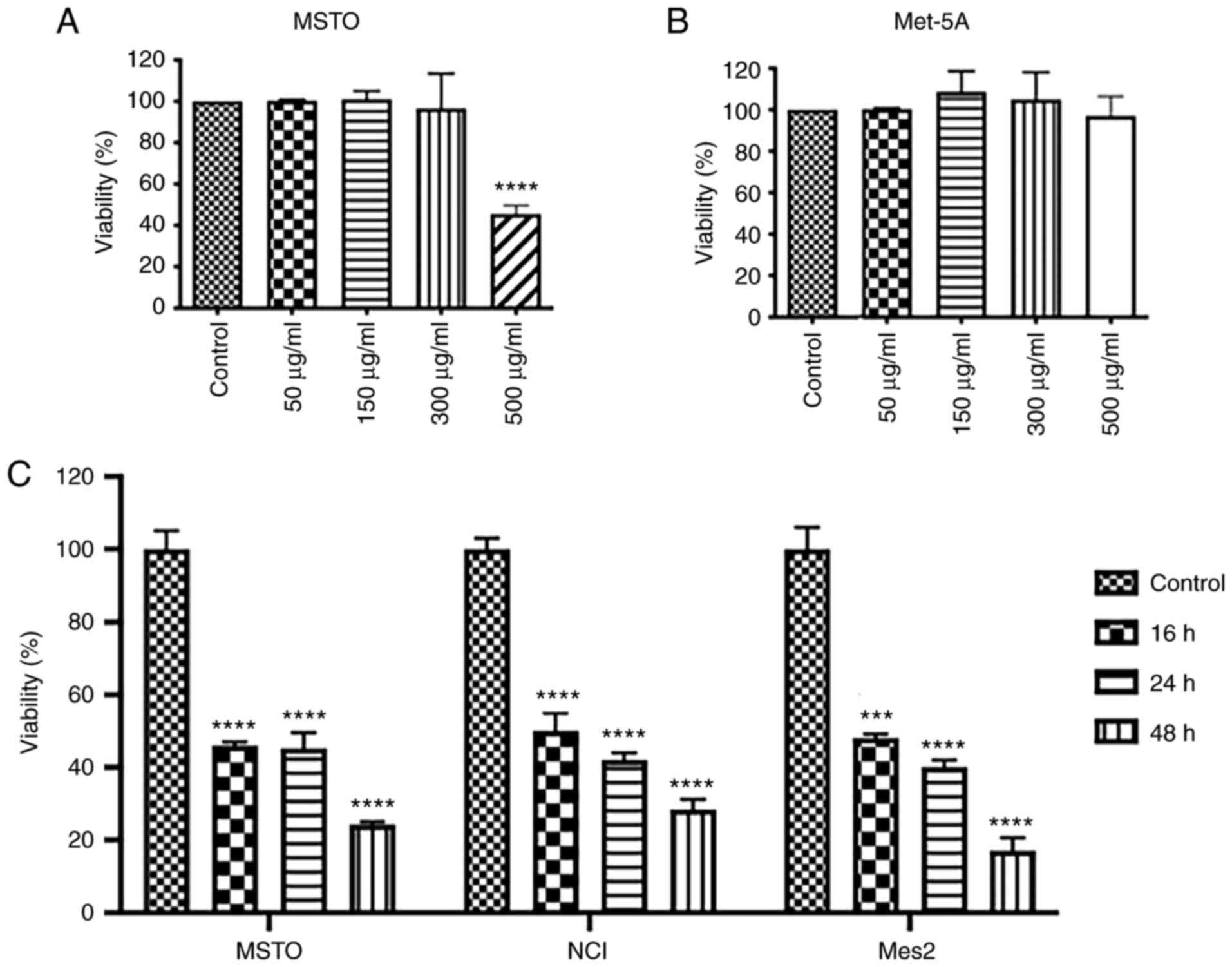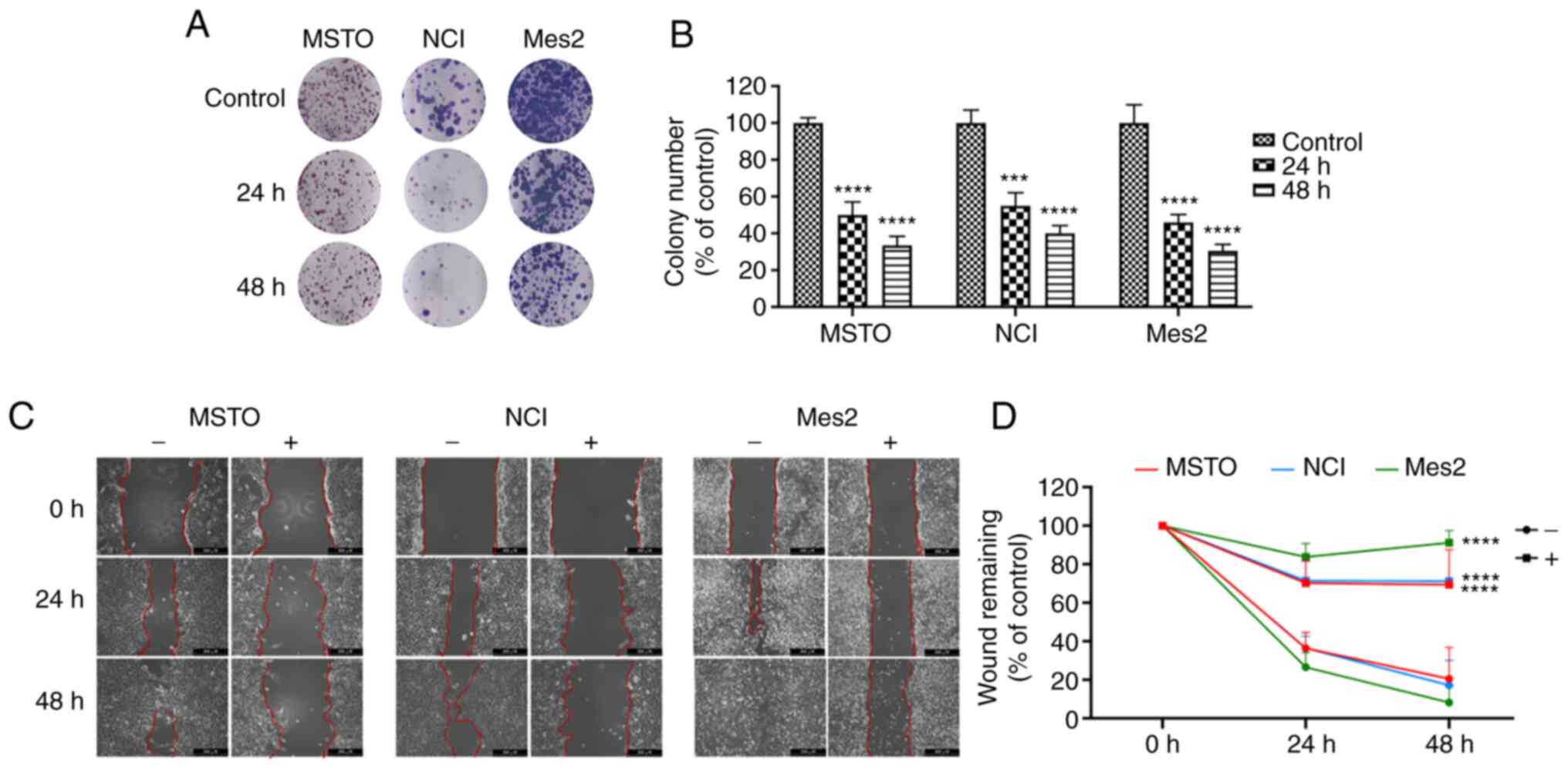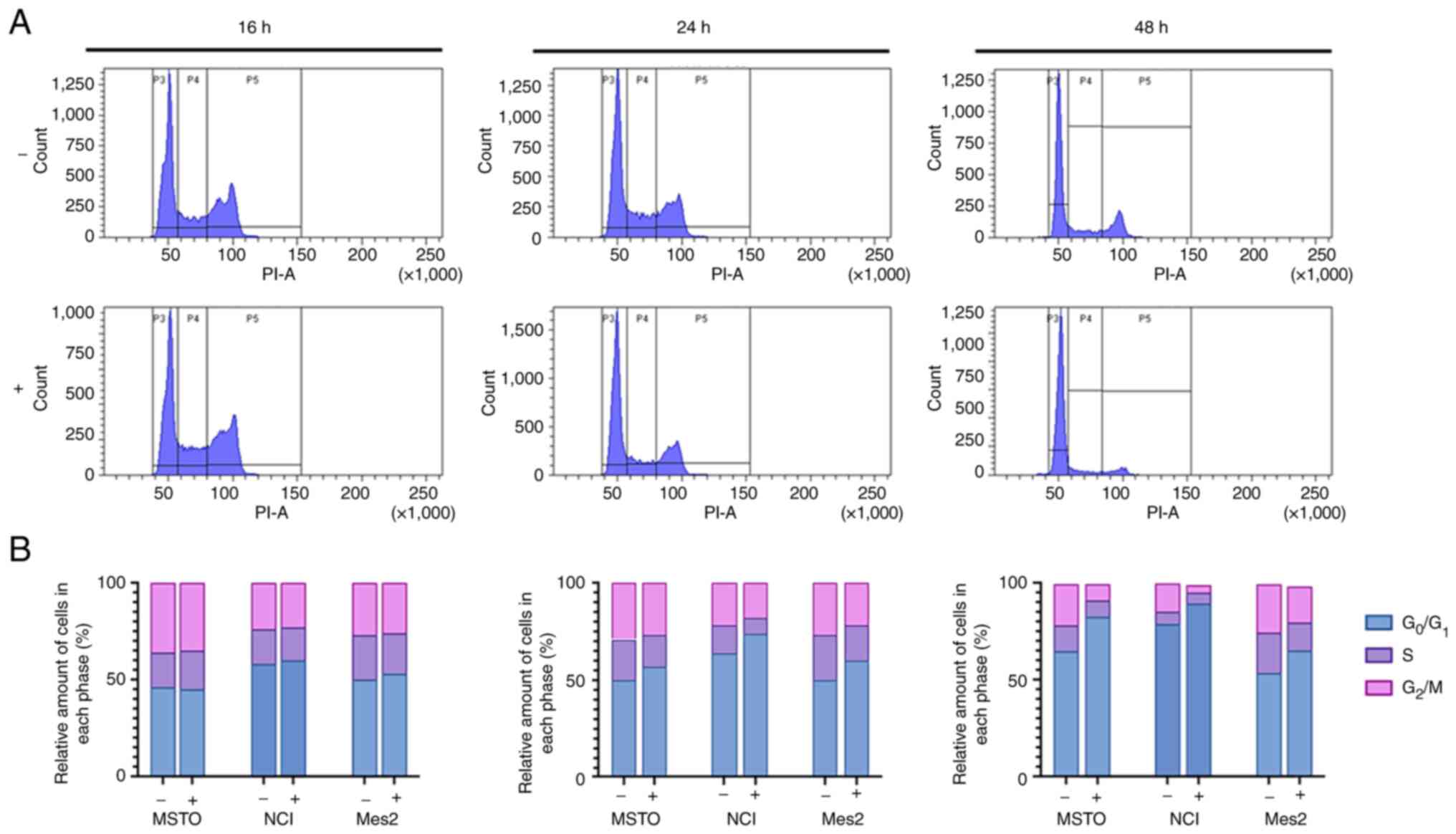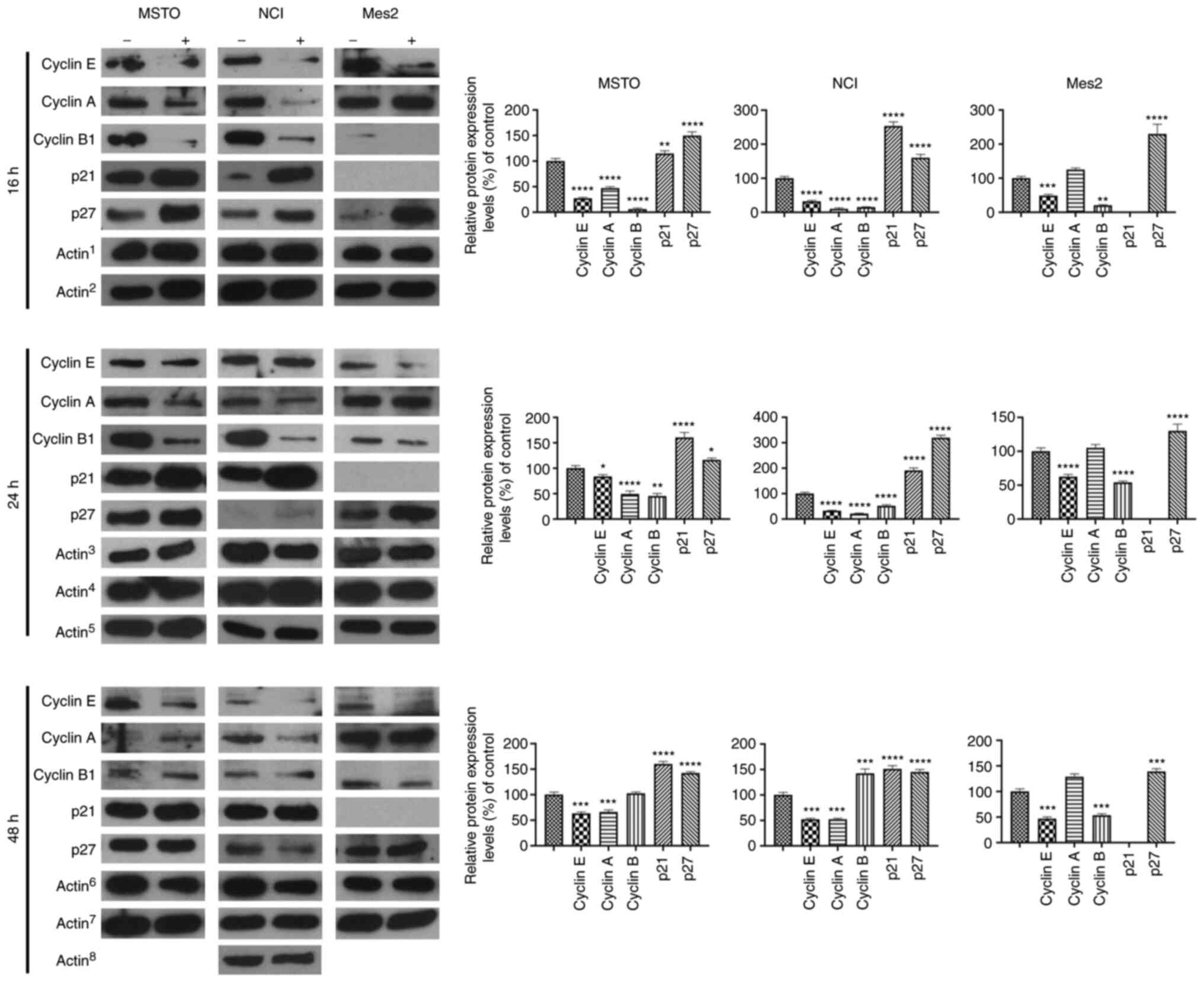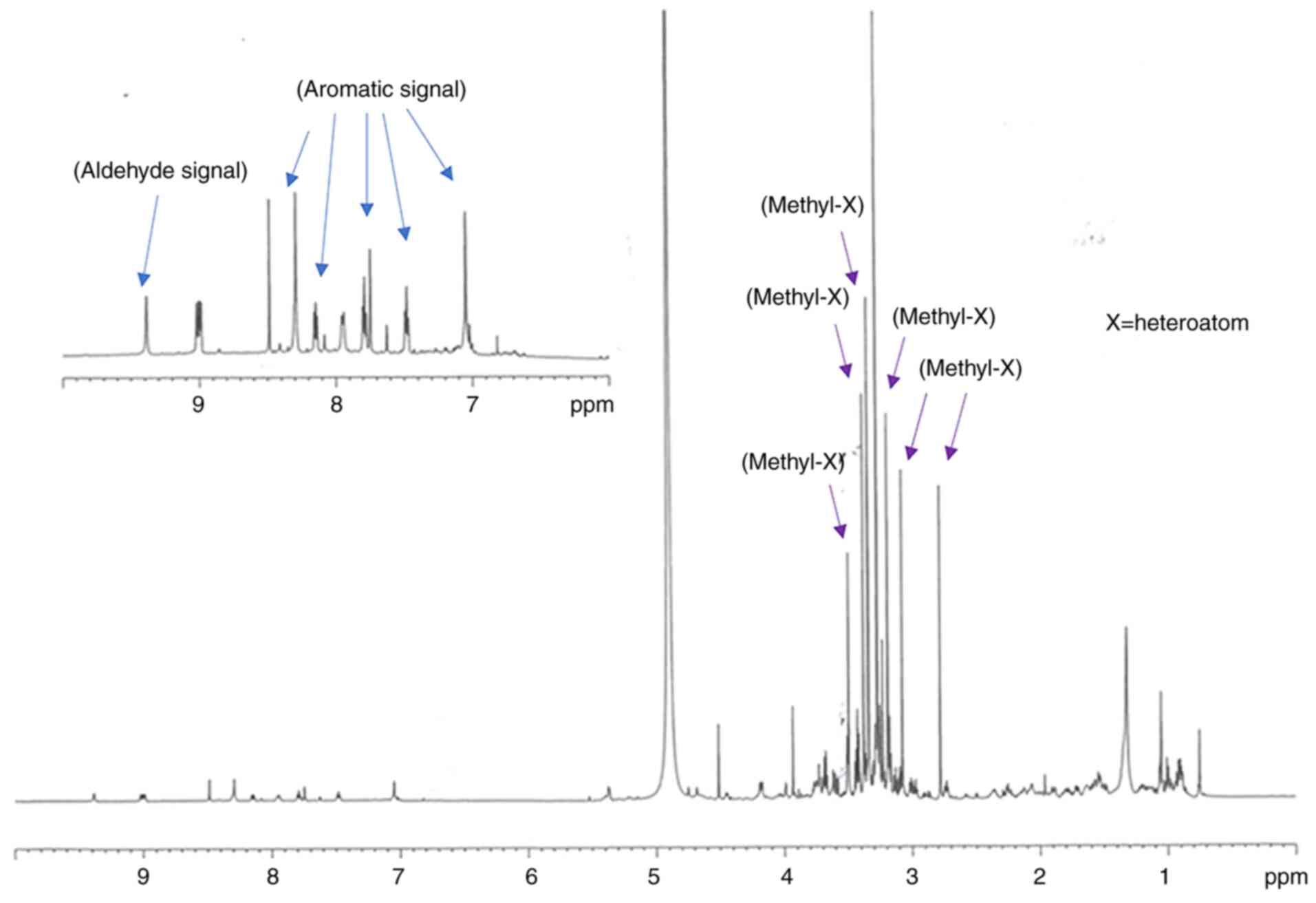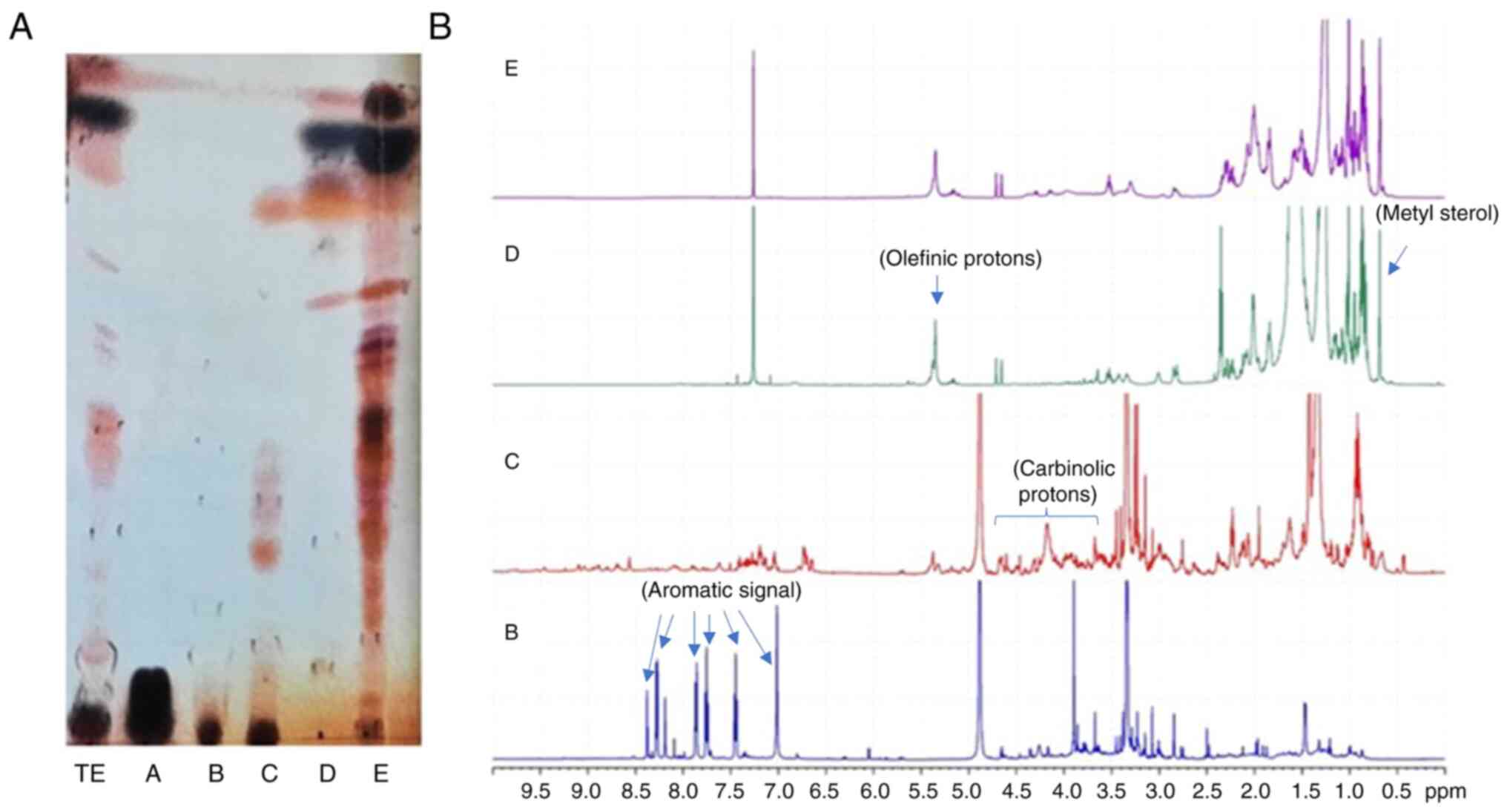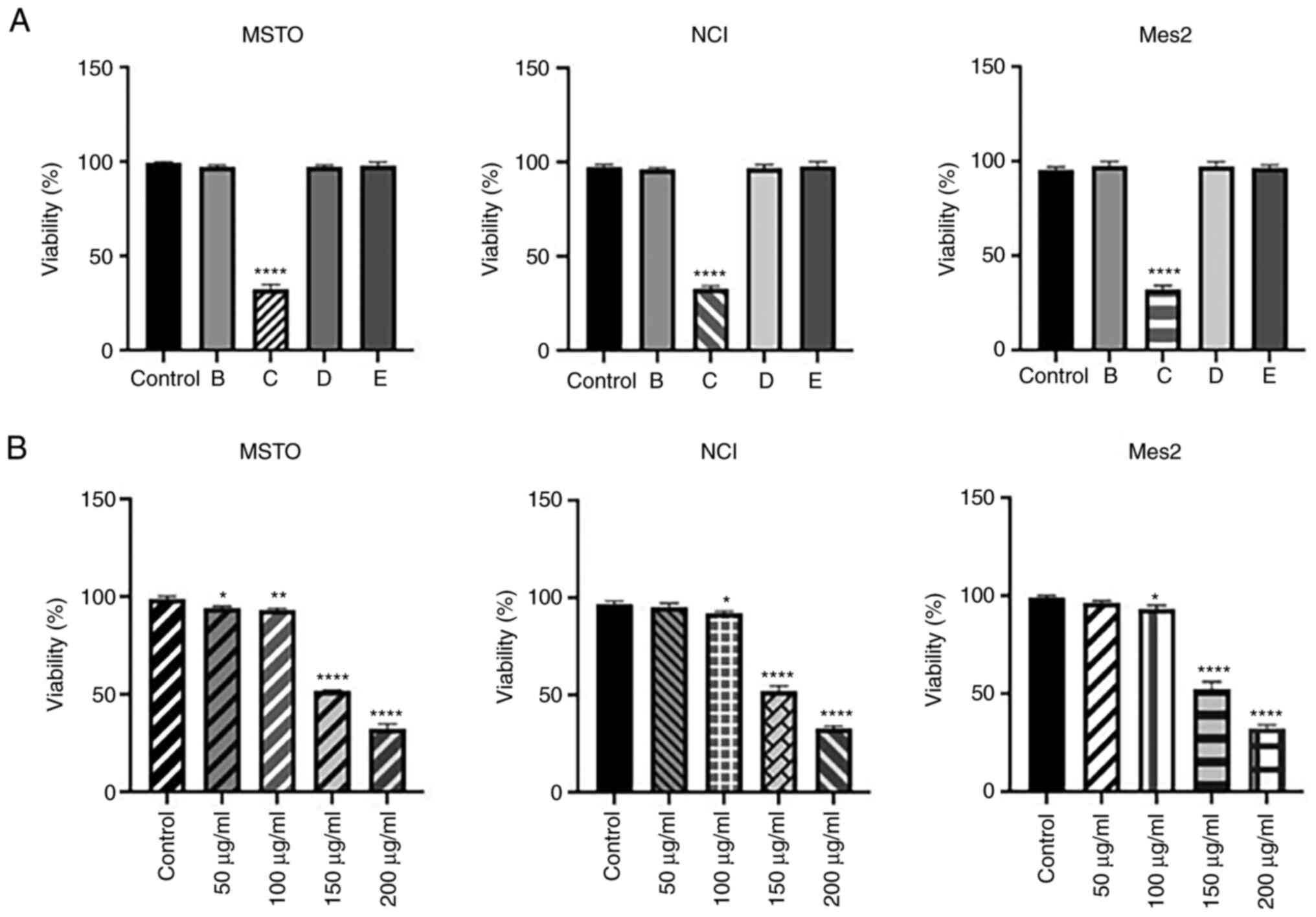Organic extract of Geodia cydonium induces cell cycle block in human mesothelioma cells
- Authors:
- Published online on: June 28, 2022 https://doi.org/10.3892/ol.2022.13406
- Article Number: 286
-
Copyright: © Di Meo et al. This is an open access article distributed under the terms of Creative Commons Attribution License.
Abstract
Introduction
In recent decades, the search for active compounds from natural sources, mainly for pharmacological applications, has represented an important challenge (1). The increasing incidence of severe diseases, such as cancer, demand an urgent need to discover new drugs. Standard drugs have notable toxicity and their use is often associated with tumor resistance, thus the development of more effective therapies is required. In addition, natural anticancer compounds, unlike synthetic drugs, are able to inhibit tumor growth with minimal side effects (2). Particularly intriguing is the identification of molecules from the marine environment to be used in pharmaceuticals. Notably, oceans cover >70% of the earth surface and display higher biodiversity than the terrestrial environment; therefore, they have become an interesting source for the discovery of novel drugs. To date, oceans are still a largely unexplored environment, suggesting them as promising candidates for sources of biologically active natural compounds (3,4). Notably, soft-bodied sessile marine invertebrates, such as sponges, are able to produce several secondary metabolites for their survival in different habitats, which are used to counterattack predators, and in competition for space and nutrients. These bioactive compounds could be useful in pharmacological, nutraceutical and cosmeceutical applications (5,6).
Sponges represent the most studied marine organisms as sources of bioactive compounds (1,3,4). Previous studies have reported the bioactivity of different marine sponge extracts in several diseases and some extracts have been used to produce commercial anticancer drugs (7). Among sponges, the bioactivity of the Mediterranean sponge Geodia cydonium has been poorly characterized. Our previous study reported the anti-inflammatory and anticancer effects of G. cydonium organic extracts on breast cancer cells (8,9).
To the best of our knowledge, the present study was the first to evaluate the antiproliferative potential of G. cydonium extract (GEOCYDO) in mesothelioma, which is a rare and aggressive type of cancer associated with exposure to asbestos fibers that exhibits high chemoresistance (10). The present study used three human mesothelioma cell lines, MSTO-211H (MSTO), NCI-H2452 (NCI) and Ist-Mes2 (Mes2), which differ in their sensitivity (MSTO and NCI) and resistance (Mes2) to standard combined treatment with cisplatin and piroxicam (11). The aim of the present study was to analyze the effect of GEOCYDO on mesothelioma, a type of cancer characterized by high chemoresistance. The present study indicated that the extract affects mesothelioma cell viability and that the fraction C could be the one responsible for its antiproliferative effects, being the most active against the three mesothelioma cell lines. Furthermore, preliminary chemical analysis of fraction C (12) revealed a complex metabolic profile, which requires further fractionation for identification of the active metabolite. To the best of our knowledge, the present study provided novel findings, as despite the large number of marine compounds assessed as drug candidates in various types of cancer (13), no previous study has referred to their use in mesothelioma.
Materials and methods
Collection of biological material
The present study did not involve protected species. G. cydonium (order, Tetractinellida; family, Geodiidae) samples were collected at 20 m in depth by scuba diving at the ‘Parco Sommerso di Baia’ (Naples, Italy). As soon as the samples were collected, they were stored at −20°C until further analysis.
G. cydonium extraction
Lyophilized sponge tissue (200 g wet weight) was extracted with methanol at room temperature. After sonication (5 min, 59 KHz, 26°C), the organic extract was dried under nitrogen flow and maintained at −20°C until further use. The extraction step was repeated three times. The extract was filtered through Whatman filter paper to recover solvent residues, and was then evaporated at low pressure in a rotavapor at 28°C and dissolved in methanol. The final extract was dried and stored at −20°C until use. For the NMR analysis (Pulprog: zg), the dry extract was dissolved in deuterated methanol (CD3OD) and transferred to a NMR tube. NMR spectra were recorded on Bruker DRX 600 spectrometer equipped with an inverse TCI CryoProbe (Bruker Corporation). Chemical shift values are reported in ppm (δ) and referenced to internal signals of residual protons (CD3OD, 1H 3.34).
Cell culture and chemicals
Human mesothelioma cell lines MSTO and NCI, and the human mesothelial cell line MeT-5A were grown in RPMI supplemented with 10% FBS (both from Euroclone SpA), glutamine (2 mM), sodium pyruvate and antibiotics (0.02 IU/ml penicillin and 0.02 mg/ml streptomycin). Human mesothelioma Mes2 cells were cultured in DMEM (Euroclone SpA), supplemented with 10% FBS, glutamine (2 mM), 1% nonessential amino acids and antibiotics (0.02 IU/ml penicillin and 0.02 mg/ml streptomycin). MSTO, NCI and MeT-5A cells were obtained from the American Type Culture Collection, and Mes2 cells were obtained from the Istituto Nazionale per la Ricercasul Cancro-Genova.
Fractionation of the methanolic extract of G. cydonium
A small amount of the active methanol extract (~40 mg) was subject to SPE using CHROMABOND® HRX cartridges (6 ml/500 mg; Macherey-Nagel) on a GX-271 ASPEC (Gilson, Inc.) (12). The extract was suspended in 1 ml distilled water and sonicated (59 KHz, 26°C), for a few seconds in an ultrasonic bath before loading onto the column, which was previously conditioned with 3 ml methanol and equilibrated with 6 ml distilled water. This fractionation yielded five fractions (A, B, C, D and E) obtained by stepwise elution with H2O (6 ml), CH3OH/H2O 7:3 (9 ml), CH3CN/H2O 7:3 (9 ml), CH3CN (9 ml) and CH2Cl2/CH3OH 9:1 (9 ml), respectively. The total extract (TE) and SPE fractions B-E were tested for cytotoxicity. The organic extract and fractions were then analyzed by thin layer chromatography (TLC) stained with Ce(SO4)2 and a preliminary chemical characterization was carried out by 1H-NMR spectrum in CD3OD. Each SPE fraction was dissolved in deuterated solvent (CD3OD for GCYD-2B and 2C; CDCl3 for GCYD-2D and 2E) and transferred to an NMR tube to acquire 1H-NMR spectra (Pulprog: zg), as already reported for G. cydonium extract. Bidimensional NMR experiments heteronuclear single quantum coherence edited (HSQCed) (Fig. S1) and heteronuclear multiple bond correlation (HMBC) (Fig. S2) in CD3OD were also acquired on the active SPE fraction C. NMR spectra were recorded on a Bruker DRX 600 spectrometer equipped with an inverse TCI CryoProbe. Chemical shift values are reported in ppm (δ) and referenced to internal signals of residual protons (CD3OD, 1H 3.34; CDCl3, 1H 7.26).
The extract and fractions were dissolved in 100 mM DMSO and dilutions were made to obtain the different concentrations to be tested, with a final concentration of 0.05% DMSO. Details on fractionation and analysis are reported in Figs. S1 and S2.
To evaluate the bioactivity of SPE fractions, MSTO, NCI and Mes2 cells were treated with 200 µg/ml of the four enriched samples (B-E) for 24 h at 37°C; this concentration was selected as this concentration of the total extract did not affect cell viability.
Cell viability assay
For each cell line, ~1×104 cells/well were plated in 48-well plates and were treated with GEOCYDO at different concentrations (50, 150, 300 and 500 µg/ml) for 16, 24 or 48 h at 37°C in humified atmosphere containing 5% CO2. For fraction bioactivity analysis, cells were treated with 200 µg/ml SPE fractions B, C, D and E for 24 h at 37°C. Subsequent analysis with 50, 100, 150 and 200 µg/ml fraction C for 24 h at 37°C was performed done to establish the half maximal inhibitory concentration (IC50) concentration. For all experiments, cells treated with the same amount of vehicle (0.1% DMSO; MilliporeSigma) present in the extract were used as a control.
Cell viability was evaluated counting live cells using MTS assay (CellTiter 96; Promega Corporation) according to the manufacturers' instructions. For the MTS assay, treated cells were incubated with 20 µl MTS reagent for 2 h at 37°C. The absorbance was recorded on a microplate reader at a wavelength of 490 nm (VICTOR Multilabel Plate Reader; PerkinElmer, Inc.). All experiments were performed in triplicate and data are expressed as the mean ± SD.
Colony formation assay
Colony formation was assessed as previously reported by our group (14). For each cell line, 500 cells/well were plated in six-well plates, incubated for 7 days and then treated with 500 µg/ml GEOCYDO for 24 or 48 h under culture conditions before replacing the media. The growth was assessed for a further 7 days and then crystal violet was used to stain the colonies, which were successively counted. Briefly, cells were fixed with formaldehyde (3.7%) for 10 min at room temperature, then washed with PBS and stained for 10 min with crystal violet (0.5%) at room temperature. The absorbance was measured at 595 nm using a microplate reader (Cytation3 ASHI; BioTek Corporation). A scanner (Epson Stylus Photo, PX 650; Epson) was used to capture images of representative plates. All experiments were performed in triplicate and data are expressed as the mean ± SD.
Wound-healing assay
The wound-healing assay was performed as previously reported (14,15). For each cell line, ~3×105 cells/well were seeded in six-well plates. After overnight incubation at 37°C, cells were at 90% confluence and wounds were created using a 200-µl pipette tip. After wound generation, cells were treated using the aforementioned culture medium, with 500 µg/ml GEOCYDO or 0.1% DMSO for 24 or 48 h. To analyze cell migration, at least six representative images for each scratch were taken in different areas at different time points. A phase contrast light microscope (DMI8; Leica Microsystems GmbH) was used to capture images of the representative plates. ImageJ software (version 1.52; National Institutes of Health) and its wound healing assay macro was used to measure wound healing. All experiments were performed in triplicate and data are expressed as the mean ± SD.
Cell cycle analysis
After overnight incubation, ~7.5×105 cells/well were plated in 100-mm plates, serum starved for 24 h and then treated with 500 µg/ml GEOCYDO for 16, 24 or 48 h at 37°C. PBS was used to wash the cells, which were then fixed in cold 70% ethanol for 30 min at 4°C. After centrifugation at 850 × g for 8 min at 4°C, cells were washed twice with cold PBS and cell pellets were dissolved in 500 µl cold PBS. To ensure only DNA was stained, cells were digested for 30 min at 37°C with 100 µg/ml RNase A. Propidium iodide (50 µg/ml) was then used to stain cells for 30 min at room temperature and the cells were then analyzed by flow cytometry (FACSCanto; BD Biosciences) using FACSDiva software (version 6.1.3; BD Biosciences). A total of 20×104 events were recorded for each sample and the percentage of cell fractions in all cell cycle phases was calculating. All experiments were performed in triplicate and data are expressed as the mean ± SD.
Western blot analysis
Protein extracts were obtained from cells treated with GEOCYDO (500 µg/ml) for 16, 24 or 48 h at 37°C as previously described (11). Total cell lysates (20 µg) were separated on 4–15% Tris-glycine gels by SDS-PAGE (Bio-Rad Laboratories, Inc.) at 100 V and proteins were then transferred to PVDF membranes (Bio-Rad Laboratories, Inc.). The membranes were blocked in 5% milk in TBS/5% Tween at room temperature for 1 h and were then probed overnight at 4°C with the specific primary antibodies, and then with horseradish peroxidase-conjugated secondary antibodies (1:10,000; cat. no. A6154; MilliporeSigma) for 1 h at room temperature according to the manufacturer's indications. The primary antibodies used for western blotting include: Anti-cyclin E (cat. no. sc-481; Santa Cruz Biotechnology, Inc), anti-cyclin A (cat. no. sc-596; Santa Cruz Biotechnology, Inc.), anti-cyclin B1 (cat. no. sc-245; Santa Cruz Biotechnology, Inc.), anti-p21 (cat. no. 2947; Cell Signaling Technology, Inc.), anti-p27 (cat. no. sc-528; Santa Cruz Biotechnology, Inc.) and anti-β-actin (cat. no. 3700; Cell Signaling Technology, Inc.), which was used as a loading control, at the concentrations suggested by manufacturers (1:1,000). Clarity western ECL (Bio-Rad Laboratories, Inc.) was used to detect protein bands and the blots were semi-quantified with ImageJ software. All experiments were performed in triplicate and data are expressed as the mean ± SD.
Statistical analysis
Graph Pad Prism 6.0 (GraphPad Software, Inc.) analysis was used to evaluate the difference between control and treatment groups. One-way ANOVA was used to evaluate the significance of the differences among means. Dunnett's multiple comparison test with Bonferroni post hoc correction was used to assess the significance between each treatment group and the control group. P≤0.05 was considered to indicate a statistically significant difference.
Results
GEOCYDO affects cell viability
To analyze the bioactivity of GEOCYDO on mesothelioma cells, the present study first determined, in a dose-response curve at 24 h, the amount of extract that had a lethal effect on MSTO cells. Results revealed that GEOCYDO had a IC50 of ~500 µg/ml in MSTO cells (Fig. 1A). Therefore, a concentration of 500 µg/ml was used for subsequent experiments. By contrast, the same concentration of GEOCYDO had no effect on wild-type Met-5A mesothelial cells (Fig. 1B). The present study also analyzed if the effects of GEOCYDO were increased over the time. As shown in Fig. 1C, cell viability decreased from 16 to 48 h; it was reduced by 75% in MSTO, 70% in NCI and 80% in Mes2 cells at 48 h compared with in the vehicle-treated cells.
Subsequently, cell proliferation and migration were analyzed to evaluate the anticancer potential of GEOCYDO. The results clearly showed that GEOCYDO was able to impair cell proliferation, reducing cellular self-renewal ability and long-term proliferative potential in all of the cell lines tested. Notably, treatment with 500 µg/ml GEOCYDO inhibited colony formation after 24 and 48 h, and the ability to produce colonies was reduced by ~50% after 24 h, and by 65, 60 and 70% after 48 h in MSTO, NCI and Mes2 cells, respectively (Fig. 2A and B). In addition, to measure the migratory capability of cells, a wound-healing assay was performed, where scratched cells were treated with GEOCYDO. The results showed that GEOCYDO significantly inhibited the ability of cells to close the gap in all of the cell lines (Fig. 2C and D). By contrast, in the untreated cells, the wound gap was closed at the end of the treatment. Notably, this experiment does not completely distinguish if GEOCYDO treatment affects cell migration or proliferation, since it was not performed in low serum conditions; thus, proliferation inhibition was analyzed in more detail.
GEOCYDO extract induces G0/G1 cell cycle arrest
To explore the mechanisms underlying the inhibition of mesothelioma cells induced by GEOCYDO, cell cycle distribution was analyzed by flow cytometry. Cells were analyzed following treatment with GEOCYDO for 16, 24 or 48 h, in order to analyze cell proliferation modifications. As shown in Figs. 3 and S1, untreated MSTO cells exhibited a typical cell cycle distribution over time, whereas GEOCYDO treatment induced a cell cycle arrest at 24 and at 48 h, as shown by an increased percentage of the cell population in the G0/G1 phase. Notably, alongside the increase in the G0/G1 cell population, there was a corresponding reduction in the population of cells in S and G2/M phases. Similar results were obtained with NCI and Mes2 cells (Fig. 3 and Fig. S3). Specifically, the percentage of cells arrested in G0/G1 phase was increased after 24 and 48 h in all of the cell lines analyzed; conversely, a slight decrease in the percentage of cells in S and G2/M phases was found.
To assess the effects of GEOCYDO, the expression levels of different cyclins and of two CDK inhibitors (CDKIs), p21 and p27, which are crucial for cell cycle progression, were detected. In particular, the expression levels of cyclin E, which is required for cell cycle G1/S transition, of cyclin A, which is needed for the G2/M transition, and of cyclin B1, which is the mitotic cyclin, were detected. The analysis indicated a decrease in the expression levels of cyclin E in MSTO, NCI and Mes2 cells, which was in agreement with the observed cell cycle arrest (Fig. 4). Considering that cyclin E can regulate the passage between phase G1 and S, these results confirmed that GEOCYDO blocked the transition between those two cell cycle phases. Cyclin A exhibited a similar decreased expression in MSTO and NCI cells, whereas it was not modulated in Mes2 treated cells compared with control cells. By contrast, cyclin B1 expression was decreased at 16 and 24 h in MSTO and NCI treated cells compared with in the control cells, and at all timepoints in Mes2 treated cells compared with in the control cells. The differences in the expression of cyclin B1 between the different cell lines could be related to the tumorigenicity of the cell lines. Finally, the decreased expression level of cyclins was accompanied by an increase in the expression levels of p21 and p27 in MSTO and NCI treated cells compared with in the control cells, and of p27 in Mes2 treated cells compared with in the control cells.
Analysis of GEOCYDO and SPE fractions
Spectroscopic analysis of GEOCYDO indicated that the active methanolic extract was very rich in metabolites. Proton signals in the region at low field showed the presence of aromatic compounds (blue arrows in Fig. 5), whereas the abundance of methyl singlets in the region between 2.7 and 3.7 ppm suggested the occurrence of heteroatom-containing compounds (purple arrows in Fig. 5). Fractionation of GEOCYDO by SPE-HRX column led to five new samples: Salts were eluted in fraction A, whereas the enriched fractions B-E, contained different classes of metabolites. As shown in Fig. 6, according to the expected resolution of the method (12), chemical analysis of the SPE fractions clearly indicated the presence of water-soluble metabolites in fraction A (mainly sugars); nucleosides and nitrogen-containing compounds in fraction B; complex lipids, including sphingolipids, lipopeptides, glycolipids and phospholipids in fraction C; sterols, terpenes, alcohols and fatty acids in fraction D; and triglycerides and neutral lipids in fraction E.
To evaluate the bioactivity of SPE fractions, MSTO, NCI and Mes2 cells were treated with 200 µg/ml of the four enriched samples (B-E) for 24 h; this concentration was selected as this concentration of the total extract did not affect cell viability. Cell viability analysis indicated that only fraction C was able to decrease viability in all cell lines (Fig. 7A). Subsequent analysis using various concentrations of fraction C (50–200 µg/ml) for 24 h confirmed its strong cytotoxicity on all mesothelioma cell lines analyzed, lowering the IC50 of GEOCYDO to ~150 µg/ml (Fig. 7B).
Preliminary 1H-NMR and TLC analysis of the enriched fraction C indicated a prevalence in this fraction of polar minor metabolites (Fig. 6). However, although the composition of fraction C is very complex and produced a crowded NMR spectra with several overlapping signals, these data are consistent with the presence of molecules with cyclodepsipeptide or a macrolide skeleton (Figs. S2 and S3). In detail, spectroscopic data of this fraction revealed a chemical signature with several methine groups between 4 and 5 ppm, coupled with carbon between 50 and 60 ppm that could be diagnostic of amino acid skeletons, and various methine and methylene signals between 3.5 and 4.10 ppm coupled with oxygen-bearing carbon between 62 and 75 ppm (Fig. S1). In the HMBC spectrum (Fig. S2), these signals also showed correlations with ester functions at 170–175 ppm. In addition to methoxy moieties, the NMR spectra supported the presence of a carbonyl group below 210 ppm (Fig. S2), several methyl groups (1H NMR signals at 0.57, 0.76, 0.82, 1.03 ppm; 13C NMR signals at 25.3, 21.1, 15.9, 19.8 ppm), and various down-shifted protons between 6.5 and 7.3 ppm of conjugated unsaturated systems (Fig. S1). Unfortunately, the amount of fraction C available was not enough to complete the characterization of the active metabolite.
Discussion
To the best of our knowledge, the present study was the first to describe the in vitro antiproliferative effect of GEOCYDO extract on mesothelioma, a rare but very aggressive cancer characterized by high chemoresistance (10,14). Mesothelioma displays a long latency period (30–40 years) and a generally unfavorable outcome (10). Despite several reports in the literature on marine sponges (2,16–18), few studies have assessed the biotechnological applications of one of the major sources of bioactive natural products, G. cydonium. Our group previously reported that a methanolic extract from this sponge had an anti-inflammatory and pro-apoptotic effect on breast cancer cell lines (8,9).
The results of the present study clearly indicated that GEOCYDO was able to affect mesothelioma cancer properties acting on cell proliferation in a time-dependent manner. Cytofluorimetric analysis revealed that GEOCYDO induced cell cycle arrest at G0/G1 phase, which may induce inhibition of proliferation in mesothelioma. The present findings were confirmed by expression analysis of proteins involved in cell cycle arrest. Notably, specific alterations in the expression levels of cyclins A, E and B1, and of CDKIs p21 and p27, were detected (19).
Cell cycle progression is a finely tuned event regulated by protein kinase complexes containing cyclins and CDKs (20). In response to DNA damage, cell proliferation undergoes arrest until DNA is repaired and correctly replicated. Cell cycle arrest can occur at two specific checkpoints of the cell cycle: G1/S and G2/M (21). It is known that cyclin E represents the key molecule of the G1/S checkpoint. The binding of endogenous CDKis, such as p21 and p27, regulates the activity of the complex cyclin E-CDK2 (22). Furthermore, the induction of p21 and p27 arrests cell cycle in the G1 phase, thus inhibiting the cells from entering the S phase for replication (23). It is known that cyclin E overexpression can promote cancer progression, whereas its downregulation, by limiting cell cycle progression to the G0/G1 phase, can decrease and inhibit tumor cell proliferation (24,25). Similarly, p21 and p27 act as tumor suppressors by controlling cell cycle progression and cell proliferation (26–28); decreased expression levels of p21 and p27 have been detected in various types of human cancer (29–31). Finally, the efficacy of GEOCYDO in Mes2 cells that do not express p21, can be ascribed to the activity of p27 that regulates cell cycle progression through decreasing p21 expression (32).
The ability of GEOCYDO to induce G1/S cell cycle arrest was confirmed by protein analysis, showing a downregulation in cyclin E, cyclin A and cyclin B1 expression, and a concomitant activation of p21 and p27. A hallmark of cancer is represented by uncontrolled and rapid cell division (2); therefore, the inhibition of cell cycle progression may be a powerful anticancer approach.
Natural marine compounds are known to exert anticancer activity in vitro and in vivo (33,34), as well as in clinical settings (35), by acting on the cell cycle (36). Several extracts have been described to induce cell cycle perturbations in various tumor cell lines. Extracts from the Lissodendorix sponge have been described to act by preventing microtubule assembly (37–39). The antiproliferative activity of an extract from the Negombata magnifica sponge has been related to specific G0/G1 and G2/M cell cycle block (40). Furthermore, marine sponge compounds derived from Jaspis stellifera and Monanchora viridis have been reported to induce cell cycle arrest through the reduction of cyclin D1 expression (2,41). These findings are in agreement with the present findings, which demonstrated that GEOCYDO blocked the transition between phase G1 and S, as indicated by the decrease in the expression levels of cyclin E, the key protein that regulates this passage.
Finally, to the best of our knowledge, the preliminary results from spectroscopic analysis indicated for the first time that GEOCYDO contained different active metabolites. The results are particularly promising since, to date, the knowledge of secondary metabolites derived from members of the genus Geodia (class, Demospongiae; family, Geodiidae) remains limited. The bioactivity of GEOCYDO was initially tested using the TE, after which the TE was fractionated and the different fractions were analyzed to identify the active fraction; the results revealed that fraction C was responsible for the bioactivity of GEOCYDO.
Molecular networking analysis of the bioactive GEOCYDO extract revealed that it may contain different molecules, such as nucleosides and amino acids, which are currently providing lead compounds for new drugs as main constituents (9). In particular, previous studies have reported that different nucleosides exert antiviral, anticancer and hypertensive effects (42,43); and that some amino acids have a high specificity against cancer cells (44). Moreover, GEOCYDO was shown to contain 3-hydroxyquinaldic acid, a chromophore present in natural antitumor agents that is required for DNA intercalation being able to binds duplex (45). In addition, the SPE fraction C exerted the strongest activity on mesothelioma cancer cell lines, as revealed by the IC50 value, suggesting this fraction may be enriched in a specific molecule that is responsible of the observed effect. Although fractionation of the extract highlighted the general characteristics of the compounds that are likely responsible for the activity of the extract, fraction C is still a complex mixture of metabolites; therefore, further chemical purifications are required to isolate and characterize the active compound.
The present results are novel since, despite the large number of marine compounds used as drug candidates in various types of cancer, to the best of our knowledge, none have assessed their effects on mesothelioma. The results of the present study also suggested that new molecules from marine organisms could be further investigated for novel treatment of this type of cancer, which is characterized by high chemoresistance.
In conclusion, GEOCYDO extract from the marine sponge G. cydonium could be considered a novel candidate as a potential antitumor drug for human malignant mesothelioma. This is a very important step in development of alternative and more effective therapies to cure mesothelioma, considering that to date the standard therapies, including chemotherapy, surgery and radiotherapy, have produced unsatisfactory outcomes (46).
Supplementary Material
Supporting Data
Acknowledgements
The authors would like to thank the Dr Laura Pisapia (IGB-CNR FACS Core Facility); Dr Maria Rosaria Aletta (IGB-CNR) and Dr Chiara Nobile (IBBR-CNR) for bibliographic assistance; and Dr Valentina Brasiello (IBBR-CNR) for editing assistance. The authors would also like thank Dr. Enrico Gallocchio (‘Parco Sommerso di Baia’, Naples), Dr Francesco Terlizzi and Dr Marco Cannavacciuolo (Fishing Service of Stazione Zoologica Anton Dohrn) for providing Geodia cydonium; and Dr Davide Caramiello (Marine Organisms Core Facility, Stazione Zoologica) for his technical support in sponge maintenance.
Funding
This research was partially funded by CNR project NUTR-AGE (grant nos. FOE-2019 and DSB.AD004.271). Francesco Di Meo's PhD fellowship in Biology is supported by MIUR project PON ‘Dottorati Innovativi con caratterizzazione industriale’ 2017–2018. Roberta Esposito was supported by a PhD (PhD in Biology, University of Naples Federico II) fellowship funded by the Photosynthesis 2.0 project of the Stazione Zoologica Anton Dohrn. Rossana Cuciniello was supported by a PhD (PhD in Biology XXXVI cycle, University of Naples Federico II) fellowship funded by CNR/IRCCS Neuromed. Nadia Ruocco was supported by a research grant ‘Antitumor Drugs and Vaccines from the Sea (ADViSE)’ project (PG/2018/0494374).
Availability of data and materials
The datasets used and/or analyzed during the current study are available from the corresponding author on reasonable request.
Authors' contributions
SC, MC, SF and AF conceptualized the study. FDM, RC, MA and GF performed cellular and molecular biology experiments. GN, AF, NR and RE performed chemical extraction. FDM, RC, MA, GF, NR and RE performed data analysis. SC, MC, NR, RE, FDM and RC were responsible for original draft preparation. FDM, RE, RC, GF, MA, NR, GN, AF, SF, SC and MC confirm the authenticity of all the raw data. All authors have read and approved the final version of the manuscript.
Ethics approval and consent to participate
Not applicable.
Patient consent for publication
Not applicable.
Competing interests
The authors declare that they have no competing interests.
References
|
Skropeta D, Pastro N and Zivanovic A: Kinase inhibitors from marine sponges. Mar Drugs. 9:2131–2154. 2011. View Article : Google Scholar : PubMed/NCBI | |
|
Bailon-Moscoso N, Cevallos-Solorzano G, Romero-Benavides JC and Orellana MI: Natural compounds as modulators of cell cycle arrest: Application for anticancer chemotherapies. Curr Genomics. 18:106–131. 2017. View Article : Google Scholar : PubMed/NCBI | |
|
Blunt JW, Copp BR, Keyzers RA, Munro MH and Prinsep MR: Marine natural products. Nat Prod Rep. 31:160–258. 2014. View Article : Google Scholar : PubMed/NCBI | |
|
Mehbub MF, Lei J, Franco C and Zhang W: Marine sponge derived natural products between 2001 and 2010: Trends and opportunities for discovery of bioactives. Mar Drugs. 12:4539–4577. 2014. View Article : Google Scholar : PubMed/NCBI | |
|
Romano G, Costantini M, Sansone C, Lauritano C, Ruocco N and Ianora A: Marine microorganisms as a promising and sustainable source of bioactive molecules. Mar Environ Res. 128:58–69. 2017. View Article : Google Scholar : PubMed/NCBI | |
|
Giordano D, Costantini M, Coppola D, Lauritano C, Pons LN, Ruocco N, di Prisco G, Ianora A and Verde C: Biotechnological applications of bioactive peptides from marine sources. Adv Microb Physiol. 73:171–220. 2018. Malve H: Exploring the ocean for new drug developments: Marine pharmacology. J Pharm Bioallied Sci 8, 83–91, 2016. View Article : Google Scholar | |
|
Costantini S, Romano G, Rusolo F, Capone F, Guerriero E, Colonna G, Ianora A, Ciliberto G and Costantini M: Anti-inflammatory effects of a methanol extract from the marine sponge geodia cydonium on the human breast cancer MCF-7 cell line. Mediators Inflamm. 2015:2049752015. View Article : Google Scholar : PubMed/NCBI | |
|
Costantini S, Guerriero E, Teta R, Capone F, Caso A, Sorice A, Romano G, Ianora A, Ruocco N, Budillon A, et al: Evaluating the effects of an organic extract from the mediterranean sponge geodia cydonium on human breast cancer cell lines. Int J Mol Sci. 18:21122017. View Article : Google Scholar | |
|
Crispi S, Cardillo I, Spugnini EP, Citro G, Menegozzo S and Baldi A: Biological agents involved in malignant mesothelioma: Relevance as biomarkers or therapeutic targets. Curr Cancer Drug Targets. 10:19–26. 2010. View Article : Google Scholar : PubMed/NCBI | |
|
Baldi A, Piccolo MT, Boccellino MR, Donizetti A, Cardillo I, La Porta R, Quagliuolo L, Spugnini EP, Cordero F, Citro G, et al: Apoptosis induced by piroxicam plus cisplatin combined treatment is triggered by p21 in mesothelioma. PLoS One. 6:e235692011. View Article : Google Scholar : PubMed/NCBI | |
|
Cutignano A, Nuzzo G, Ianora A, Luongo E, Romano G, Gallo C, Sansone C, Aprea S, Mancini F, D'Oro U and Fontana A: Development and application of a novel SPE-method for bioassay-guided fractionation of marine extracts. Mar Drugs. 13:5736–5749. 2015. View Article : Google Scholar : PubMed/NCBI | |
|
Calcabrini C, Catanzaro E, Bishayee A, Turrini E and Fimognari C: Marine sponge natural products with anticancer potential: An updated review. Mar Drugs. 15:3102017. View Article : Google Scholar | |
|
Di Meo F, Filosa S, Madonna M, Giello G, Di Pardo A, Maglione V, Baldi A and Crispi S: Curcumin C3 complex®/Bioperine® has antineoplastic activity in mesothelioma: An in vitro and in vivo analysis. J Exp Clin Cancer Res. 38:3602019. View Article : Google Scholar : PubMed/NCBI | |
|
Kauanova S, Urazbayev A and Vorobjev I: The frequent sampling of wound scratch assay reveals the ‘Opportunity’ window for quantitative evaluation of cell motility-impeding drugs. Front Cell Dev Biol. 9:6409722021. View Article : Google Scholar | |
|
Wellington KD, Cambie RC, Rutledge PS and Bergquist PR: Chemistry of sponges. 19. Novel bioactive metabolites from Hamigera tarangaensis. J Nat Prod. 63:79–85. 2000. View Article : Google Scholar : PubMed/NCBI | |
|
Sipkema D, Franssen MC, Osinga R, Tramper J and Wijffels RH: Marine sponges as pharmacy. Mar Biotechnol (NY). 7:142–162. 2005. View Article : Google Scholar : PubMed/NCBI | |
|
Varijakzhan D, Loh JY, Yap WS, Yusoff K, Seboussi R, Lim SHE, Lai KS and Chong CM: Bioactive compounds from marine sponges: Fundamentals and applications. Mar Drugs. 19:2462021. View Article : Google Scholar : PubMed/NCBI | |
|
Malumbres M and Barbacid M: To cycle or not to cycle: A critical decision in cancer. Nat Rev Cancer. 1:222–231. 2001. View Article : Google Scholar : PubMed/NCBI | |
|
Lim S and Kaldis P: Cdks cyclins and CKIs: Roles beyond cell cycle regulation. Development. 140:3079–3093. 2013. View Article : Google Scholar | |
|
Kastan MB and Bartek J: Cell-cycle checkpoints and cancer. Nature. 432:316–323. 2004. View Article : Google Scholar : PubMed/NCBI | |
|
Bresnahan WA, Boldogh I, Ma T, Albrecht T and Thompson EA: Cyclin E/Cdk2 activity is controlled by different mechanisms in the G0 and G1 phases of the cell cycle. Cell Growth Differ. 7:1283–1290. 1996.PubMed/NCBI | |
|
Harper JW, Elledge SJ, Keyomarsi K, Dynlacht B, Tsai LH, Zhang P, Dobrowolski S, Bai C, Connell-Crowley L and Swindell E: Inhibition of cyclin-dependent kinases by p21. Mol Biol Cell. 6:387–400. 1995. View Article : Google Scholar | |
|
Lodén M, Nielsen NH, Roos G, Emdin SO and Landberg G: Cyclin E dependent kinase activity in human breast cancer in relation to cyclin E, p27 and p21 expression and retinoblastoma protein phosphorylation. Oncogene. 18:2557–2566. 1999. View Article : Google Scholar | |
|
Lodén M, Stighall M, Nielsen NH, Roos G, Emdin SO, Ostlund H and Landberg G: The cyclin D1 high and cyclin E high subgroups of breast cancer: Separate pathways in tumorogenesis based on pattern of genetic aberrations and inactivation of the pRb node. Oncogene. 21:4680–4690. 2002. View Article : Google Scholar | |
|
Besson A, Dowdy SF and Roberts JM: CDK inhibitors: Cell cycle regulators and beyond. Dev Cell. 14:159–169. 2008. View Article : Google Scholar | |
|
Chu IM, Hengst L and Slingerland JM: The Cdk inhibitor p27 in human cancer: Prognostic potential and relevance to anticancer therapy. Nat Rev Cancer. 8:253–267. 2008. View Article : Google Scholar : PubMed/NCBI | |
|
Kreis NN, Louwen F and Yuan J: The multifaceted p21 (Cip1/Waf1/CDKN1A) in cell differentiation, migration and cancer therapy. Cancers (Basel). 11:12202019. View Article : Google Scholar | |
|
Baldi A, De Luca A, Esposito V, Campioni M, Spugnini EP and Citro G: Tumor suppressors and cell-cycle proteins in lung cancer. Patholog Res Int. 2011:6050422011. | |
|
Bachs O, Gallastegui E, Orlando S, Bigas A, Morante-Redolat JM, Serratosa J, Fariñas I, Aligué R and Pujol MJ: Role of p27 Kip1 as a transcriptional regulator. Oncotarget. 9:26259–26278. 2018. View Article : Google Scholar | |
|
Razavipour SF, Harikumar KB and Slingerland JM: p27 as a transcriptional regulator: New roles in development and cancer. Cancer Res. 80:3451–3458. 2020. View Article : Google Scholar : PubMed/NCBI | |
|
Gallastegui E, Biçer A, Orlando S, Besson A, Pujol MJ and Bachs O: p27 Kip1 represses the Pitx2-mediated expression of p21 Cip1 and regulates DNA replication during cell cycle progression. Oncogene. 36:350–361. 2017. View Article : Google Scholar : PubMed/NCBI | |
|
Ahn JH, Woo JH, Rho JR and Choi JH: Anticancer activity of gukulenin A isolated from the marine sponge. Mar Drugs. 17:1262019. View Article : Google Scholar | |
|
Chikamatsu S, Saijo K, Imai H, Narita K, Kawamura Y, Katoh T and Ishioka C: In vitro and in vivo antitumor activity and the mechanism of siphonodictyal B in human colon cancer cells. Cancer Med. 8:5662–5672. 2019. View Article : Google Scholar : PubMed/NCBI | |
|
Nastrucci C, Cesario A and Russo P: Anticancer drug discovery from the marine environment. Recent Pat Anticancer Drug Discov. 7:218–232. 2012. View Article : Google Scholar : PubMed/NCBI | |
|
Khalifa SAM, Elias N, Farag MA, Chen L, Saeed A, Hegazy MEF, Moustafa MS, El-Wahed AB, Al-Mousawi SM, Musharraf SG, et al: Marine natural products: A source of novel anticancer drugs. Mar Drugs. 17:4912019. View Article : Google Scholar | |
|
Bergamaschi D, Ronzoni S, Taverna S, Faretta M, De Feudis P, Faircloth G, Jimeno J, Erba E and D'Incalci M: Cell cycle perturbations and apoptosis induced by isohomohalichondrin B (IHB), a natural marine compound. Br J Cancer. 79:267–277. 1999. View Article : Google Scholar : PubMed/NCBI | |
|
Bitzer J, Grosse T, Wang L, Lang S, Beil W and Zeeck A: New aminophenoxazinones from a marine Halomonas sp: Fermentation structure elucidation and biological activity. J Antibiot (Tokyo). 59:86–92. 2006. View Article : Google Scholar : PubMed/NCBI | |
|
Sagar S, Esau L, Holtermann K, Hikmawan T, Zhang G, Stingl U, Bajic VB and Kaur M: Induction of apoptosis in cancer cell lines by the red sea brine pool bacterial extracts. BMC Complement Altern Med. 13:3442013. View Article : Google Scholar : PubMed/NCBI | |
|
Rady HM, Hassan AZ, Salem SM, Mohamed TK, Esmaiel NN, Ez-El-Arab MA, Ibrahim MA and Fouda FK: Induction of apoptosis and cell cycle arrest by Negombata magnifica sponge in hepatocellular carcinoma. Medicinal Chemistry Research. 25:456–465. 2016. View Article : Google Scholar | |
|
Wang R, Zhang Q, Peng X, Zhou C, Zhong Y, Chen X, Qiu Y, Jin M, Gong M and Kong D: Stellettin B induces G1 arrest apoptosis and autophagy in human non-small cell lung cancer A549 cells via blocking PI3K/Akt/mTOR pathway. Sci Rep. 6:270712016. View Article : Google Scholar : PubMed/NCBI | |
|
Huang RM, Chen YN, Zeng Z, Gao CH, Su X and Peng Y: Marine nucleosides: Structure, bioactivity synthesis and biosynthesis. Mar Drugs. 12:5817–5838. 2014. View Article : Google Scholar : PubMed/NCBI | |
|
Rajan R, Sabnani MK, Mavinkurve V, Shmeeda H, Mansouri H, Bonkoungou S, Le AD, Wood LM, Gabizon AA and La-Beck NM: Liposome-induced immunosuppression and tumor growth is mediated by macrophages and mitigated by liposome–encapsulated alendronate. J Control Release. 271:139–148. 2018. View Article : Google Scholar : PubMed/NCBI | |
|
Negi B, Kumar D and Rawat DS: Marine peptides as anticancer agents: A remedy to mankind by nature. Curr Protein Pept Sci. 18:885–904. 2017. View Article : Google Scholar | |
|
Sheoran A, King A, Velasco A, Pero JM and Garneau-Tsodikova S: Characterization of tioF, a tryptophan 2,3-dioxygenase involved in 3-hydroxyquinaldic acid formation during thiocoraline biosynthesis. Mol Biosyst. 4:622–628. 2008. View Article : Google Scholar | |
|
Baldi A, De Luca A, Maiorano P, D'Angelo C and Giordano A: Curcumin as an anticancer agent in malignant mesothelioma: A Review. Int J Mol Sci. 21:18392020. View Article : Google Scholar |



